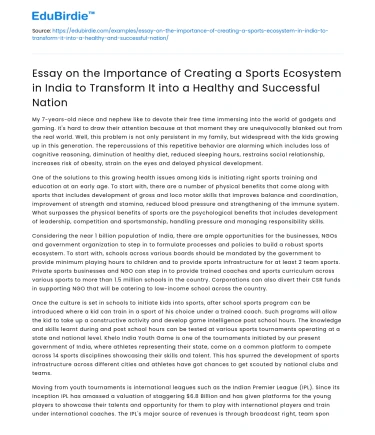My 7-years-old niece and nephew like to devote their free time immersing into the world of gadgets and gaming. It's hard to draw their attention because at that moment they are unequivocally blanked out from the real world. Well, this problem is not only persistent in my family, but widespread with the kids growing up in this generation. The repercussions of this repetitive behavior are alarming which includes loss of cognitive reasoning, diminution of healthy diet, reduced sleeping hours, restrains social relationship, increases risk of obesity, strain on the eyes and delayed physical development.
One of the solutions to this growing health issues among kids is initiating right sports training and education at an early age. To start with, there are a number of physical benefits that come along with sports that includes development of gross and loco motor skills that improves balance and coordination, improvement of strength and stamina, reduced blood pressure and strengthening of the immune system. What surpasses the physical benefits of sports are the psychological benefits that includes development of leadership, competition and sportsmanship, handling pressure and managing responsibility skills.
Save your time!
We can take care of your essay
- Proper editing and formatting
- Free revision, title page, and bibliography
- Flexible prices and money-back guarantee
Considering the near 1 billion population of India, there are ample opportunities for the businesses, NGOs and government organization to step in to formulate processes and policies to build a robust sports ecosystem. To start with, schools across various boards should be mandated by the government to provide minimum playing hours to children and to provide sports infrastructure for at least 2 team sports. Private sports businesses and NGO can step in to provide trained coaches and sports curriculum across various sports to more than 1.5 million schools in the country. Corporations can also divert their CSR funds in supporting NGO that will be catering to low-income school across the country.
Once the culture is set in schools to initiate kids into sports, after school sports program can be introduced where a kid can train in a sport of his choice under a trained coach. Such programs will allow the kid to take up a constructive activity and develop game intelligence post school hours. The knowledge and skills learnt during and post school hours can be tested at various sports tournaments operating at a state and national level. Khelo India Youth Game is one of the tournaments initiated by our present government of India, where athletes representing their state, come on a common platform to compete across 14 sports disciplines showcasing their skills and talent. This has spurred the development of sports infrastructure across different cities and athletes have got chances to get scouted by national clubs and teams.
Moving from youth tournaments is international leagues such as the Indian Premier League (IPL). Since its inception IPL has amassed a valuation of staggering $6.8 Billion and has given platforms for the young players to showcase their talents and opportunity for them to play with international players and train under international coaches. The IPL's major source of revenues is through broadcast right, team sponsorships, sale of stadium tickets and merchandise sale. The data compiled by KPMG sports advisory council group reveal that economic output associated with IPL in 2015 stood at a massive $418 million. The other direct benefits of IPL have been a rise in employment for coaches and admin staff, sports tourism and development of sports infrastructure in tier 2 cities.
With the success of IPL, there has been development of different sports league, including ISL (Indian Super League for Football), Pro Kabbadi League, Ultimate Table Tennis League, Pro Volleyball League, Hockey India League and Premier Badminton League. These leagues have opened up opportunities for foreign direct investment, where well renowned international sports club is buying a minority stake in the teams. Having a foreign club on board has improved technical expertise of the clubs where they are adopting latest sports technologies to track the performance of the players and minutely observe the opposition players. Additionally, there has been an increase in demand and job creation for sports nutrition, sports physiotherapist, sports psychologist. For the viewers they get to get to watch live sports entertainment through their mobile headsets and televisions and are inspired to play the sport of their choice in their leisure time which can improve their mental fitness leading to improved productivity at work.
We can draw inspiration from various countries that are spending heavily into grassroots and elite sports. For example, England has identified priority sport, partnered with sports organization to promote school sports and incentivized female participation in sports. USA's NCAA (National Collegiate Athletic Association) has highly competitive college and school sports leagues that has created champions across various sports disciplines. Moreover, they have a strong scholarship program to encourage sports participation and have built a strategic fitness guide. Whereas, the Swiss government is planning specific strategies to promote opportunities for sporting recreation for senior citizen. This helps the government to reduce their spending on medicines and insurance, and instead channel their funds for other purposes.
By creating an entire sports ecosystem for kids, adults and senior citizens our country will not only become healthier but also improve their productivity at work. The government needs to draft policies that will convert our massive population into playing population. If someday we are able to hold the Olympics it will massively boost foreign investment, infrastructure development, job creation and more importantly build brand India.
To summarize, various stakeholders of our country, including government and private sports businesses should take the following measures to convert India into a healthy and a successful sporting nation: 1) promotion of clubs for various sports and general fitness; 2) formation of physical education curriculum for schools; 3) establishment of organizations for providing expert advice; 4) building and maintaining community playground; and 5) massive public spending on elite fitness.






 Stuck on your essay?
Stuck on your essay?

